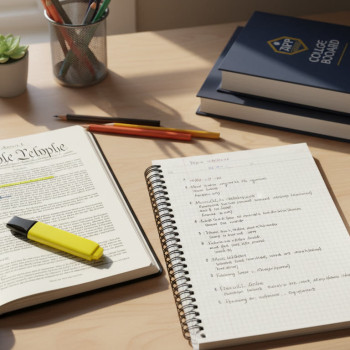AP Note Refresh Week: Why One Week Can Change Everything
Imagine opening your notebook or digital folder and instantly finding the exact explanation, formula, or quote you need. No frantic skimming. No last-minute panic. Just calm, confident preparation. That’s the aim of an AP Note Refresh Week — a focused, practical plan to clean, tag, and summarize your AP notes so your review becomes efficient, meaningful, and even enjoyable.
This post walks you through a seven-day routine you can adapt to any AP course — Biology, US History, Calculus, English Literature, Chemistry, Psychology, or any other. We’ll balance strategy with hands-on tips, real-world examples, and tools to help you convert raw notes into a study system that actually helps you ace the exam.

How Note Refresh Week Works: The Big Picture
Think of this week as a gentle, intentional spring-cleaning for your brain. Each day has a clear focus: declutter, organize, tag, create summaries, and prepare active review resources. You’ll end the week with a streamlined reference system — both digital and physical — that turns passive notes into active learning tools.
Why a full week? Because meaningful organization takes care, not speed. Spacing the work across seven focused sessions combats fatigue, helps you spot patterns, and leaves time to create high-value review aids like concise summaries and targeted practice questions.
What You’ll Need
- All your notes (notebooks, loose papers, screenshots, digital files).
- Highlighters or color pens (different colors for themes, definitions, examples).
- Sticky tabs or digital tags for quick navigation.
- A notes app or folder structure (OneNote, Notion, Google Drive, Evernote, or plain folders).
- Timer (Pomodoro-style helps).
- Quiet blocks of time: 45–90 minutes each day.
Day-by-Day Plan: Clean, Tag, Summarize
Day 1 — Gather and Glance: Inventory Everything
Goal: Collect all sources and get a fast, honest overview. Pull together physical notebooks, loose sheets, slides, screenshots, and digital notes. Lay them out or create a single digital folder labeled clearly (e.g., AP Biology 2025 Notes).
What to do:
- Sort by type: lecture notes, textbook extracts, practice problems, past quizzes, and flashcards.
- Quick skim: mark pages that feel redundant, incomplete, or messy. Don’t edit yet — just tag “Keep,” “Fix,” or “Discard.”
- Estimate time: allocate specific blocks in your calendar for the rest of the week.
Day 2 — Purge and Prioritize
Goal: Reduce clutter. Keep what’s important; toss what’s not. Students often hang on to every single slide or marginal note. That’s unnecessary and slows review.
Practical rules:
- Discard duplicates: If the same idea appears multiple times, choose the clearest version.
- Keep actual value: Retain problem sets with solutions, teacher clarifications, and test-like questions.
- Combine: Merge short, related notes into single pages or files.
Day 3 — Tag and Color-Code
Goal: Make retrieval instant. Tagging turns a pile of notes into a searchable toolkit. Use consistent categories across topics so your brain learns the system.
Suggested tag system:
- Definition / Key Term
- Essential Concept / Big Idea
- Formula / Method
- Example / Problem
- Common Mistake
- Exam Cue / Past FRQ or MCQ
Tip: Use 2–3 colors — one for core concepts, one for methods or formulas, and one for exam-style questions. Digital tags should mirror the physical colors.
Day 4 — Condense into Summaries
Goal: Create tight, one-page summaries for each unit or chapter. These are not exhaustive — they’re high-value review sheets that you can scan in 3–5 minutes before an exam.
How to build a one-page summary:
- Top: Unit title and 2–3 core learning objectives.
- Left column: Key terms and formulas.
- Right column: Quick examples and one “exam-style” tip.
- Bottom: One-sentence summary that captures the unit’s essence.
Example (AP Calculus AB — Derivatives):
- Core objectives: Understand limit definition, rules of differentiation, and applications to motion.
- Key formulas: Derivative rules, chain rule, product rule, quotient rule.
- Exam tip: Always check units for word problems; a sign error is usually the culprit.
Day 5 — Convert Notes into Active Review Tools
Goal: Turn passive notes into active practice. The brain remembers through retrieval — not rereading.
Create these essentials:
- Flashcards for key terms and formulas (real or digital like Anki).
- One-sentence cues on the front and fuller answers on the back.
- 3–5 practice problems per unit with step-by-step solutions summarized on the back of a note card or a separate file.
Pro tip: Write a one-minute explanation for each flashcard as if you’re teaching a friend. Teaching forces clarity.
Day 6 — Make a Review Calendar and Prioritize Weak Spots
Goal: Use spaced repetition. Plan quick, focused reviews using your new summaries and active tools.
How to create the calendar:
- Block 20–30 minute sessions for each unit across the next 4–6 weeks.
- Prioritize weak topics: schedule them more often.
- Include mixed practice sessions that combine multiple units to simulate exam conditions.
Sample weekly layout:
| Day | Focus | Duration | Tool |
|---|---|---|---|
| Monday | Unit A Review + Flashcards | 30 min | One-page summary + Anki |
| Wednesday | Unit B Practice Problems | 45 min | Practice set + Solutions |
| Friday | Mixed Timed Questions | 60 min | Past FRQs/MCQs |
Day 7 — Final Polish and Create a “Cheat Sheet” for Exam Week
Goal: Synthesize everything into a quick-reference cheat sheet (one or two pages) you can review the night before an exam.
What to include on the cheat sheet:
- Core definitions and formulas in an ultra-condensed format.
- 3–4 “don’t forget” exam tips for timing and common pitfalls.
- One high-yield example with steps.
This cheat sheet is not for use in the exam room — it’s for pre-exam calm and last-minute confidence.
Tools and Formats: Digital vs. Paper (and Why Both Matter)
Don’t fall into the trap of choosing sides. Each format offers strengths:
- Paper: Great for memory formation, quick sketches, and handwriting benefits. Good for one-page summaries and flashcards.
- Digital: Best for searchability, backups, tagging, and syncing across devices. Great for long-term organization and spaced repetition (Anki, Quizlet, Notion, or your notes app).
Hybrid approach: Keep one-page summaries and flashcards on paper, but maintain a synchronized digital archive with searchable tags and scanned versions of important pages. This gives you the tactile benefits of writing and the convenience of digital search.
How to Make Summaries That Actually Stick
Quality matters more than quantity. A two-page summary is far better than a five-page summary you never read. Here are three science-backed tips to make those summaries memorable:
- Use retrieval prompts rather than full explanations. A one-line cue forces you to recall, which strengthens memory.
- Include a tiny visual — a labeled diagram, timeline, or flowchart. Our brains love visual anchors.
- Write a one-sentence “why this matters” under each section to connect facts to purpose — context increases recall.
Example: AP US History — Civil Rights Movement Summary Snippet
Core Idea: Postwar activism used legal strategy, nonviolent protest, and federal policy to expand civil rights. Why it matters: Civil Rights reshaped national policy and voting patterns.
- Key Terms: Brown v. Board, Civil Rights Act (1964), Voting Rights Act (1965).
- High-Yield Example: Montgomery Bus Boycott — nonviolent, community-led, economic pressure.
- Exam Tip: Link Supreme Court decisions to shifts in federal vs. state power.
Active Review Techniques to Use with Your Refreshed Notes
It’s not enough to organize — you need to use the notes strategically. Here are active review methods that pair perfectly with your new system.
- Feynman Technique: Teach the concept in simple language, identify gaps, revisit notes, and repeat.
- Interleaving: Mix practice problems from different units in one session to build flexible understanding.
- Self-Testing: Use your flashcards and summaries to create short quizzes. Simulate exam timing for multiple-choice sections.
- Explain-Aloud Sessions: Record yourself explaining a concept. Listening back reveals knowledge gaps and builds verbal fluency for essay sections.
Time Management and Motivation Hacks
Studying for APs is a marathon, not a sprint. Here’s how to keep momentum without burning out:
- Pomodoro Blocks: 25 minutes work / 5 minutes break. After four cycles, take a longer break.
- Micro-Goals: Instead of “study Chemistry,” try “summarize acid-base titration in 30 minutes.”
- Reward System: Small rewards for finishing summaries — a favorite snack or a 15-minute walk.
- Accountability Buddy: Swap cheat sheets with a classmate and quiz each other weekly.
Using Tutoring Smartly During Refresh Week
One-on-one guidance can accelerate note refinement. If you have access to personalized tutoring, use it strategically:
- Ask tutors to review your one-page summaries and point out gaps or misinterpretations.
- Have them model how they’d condense a complex idea into a quick exam tip.
- Request targeted practice questions aligned to your weak spots identified during Day 6.
For instance, Sparkl’s personalized tutoring offers tailored study plans and expert tutors who can help you refine summaries into exam-ready formats and provide AI-driven insights to highlight likely weak spots. A short session focused on summary feedback can be one of the highest-return uses of tutoring time.
Sample Checklist: End-of-Week Audit
Use this checklist to verify your system is ready for steady review and last-minute cramming:
- All units have one-page summaries.
- Flashcards created for definitions and formulas.
- Practice problems organized with solutions.
- Digital folder is searchable and backed up.
- Review calendar scheduled for at least four weeks prior to the exam.
- Cheat sheet prepared for exam-week review.
Common Pitfalls and How to Avoid Them
Students often get stuck in familiar traps during note refresh. Here’s how to sidestep the biggest ones:
- Over-summarizing: If your summary becomes another textbook, it’s too long. Trim ruthlessly.
- Perfectionism: A clean, usable set of notes is better than an idealized but unfinished system.
- Neglecting practice: Notes without retrieval practice won’t improve scores. Pair organization with testing.
- Ignoring exam format: Tailor summaries to AP-style questions — short-answer strategies, FRQ structure, and typical MCQ traps.
Real-World Example: From Messy Notes to Exam-Ready in Two Weeks
Case study: A student taking AP Chemistry started with scattered lecture slides, partial lab reports, and practice tests. Over two weeks, they followed Refresh Week for each major unit: purified notes, created one-page summaries, and built a targeted flashcard deck. The key change was shifting from rereading to retrieval — frequent, short quizzes using the new system. The result was faster problem solving and more confidence on lab-based questions.
Measuring Progress: How to Know Your Notes Are Working
Metrics matter. Use these quick checks:
- Speed test: Time how long it takes to find an explanation for a concept — goal: under 2 minutes.
- Retention test: Can you explain a summary’s core idea 48 hours after studying? If not, revisit.
- Practice score improvement: Track scores on mixed practice sets. A steady upward trend indicates your system is paying off.
Final Thoughts: Make This Week Yours
AP Note Refresh Week is less about perfection and more about creating a system that serves your learning style. The process of cleaning, tagging, and summarizing does two things: it organizes information and forces you to think critically about what matters. That reflection is where the learning happens.
Consider a short tutoring session if you want feedback on structure or need help identifying blind spots — targeted, expert input can speed up your progress without taking you away from the work you need to do. Sparkl’s personalized tutoring is designed for that kind of efficient, high-impact support: 1-on-1 guidance, tailored study plans, expert tutors, and AI-driven insights that can point you to the exact chapters or question types you should prioritize.

Quick Start Guide: 7 Actions You Can Do Right Now
- Set up a single folder named “AP [Class] Notes 2025” and drop all files inside.
- Choose three colors for tagging and stick to them.
- Create one one-page summary for your most recent unit.
- Make 10 flashcards from that summary and test yourself tonight.
- Schedule three 25-minute Pomodoros for refresh tasks this week.
- Pick two practice problems and write step-by-step solutions in your summary margin.
- Book one short tutoring session to review your summaries and get feedback.
Closing Note
Cleaning, tagging, and summarizing is not busywork — it’s an investment in clarity. One week of focused effort makes every future hour of review more effective and less stressful. Your notes should be a launchpad for understanding, not a hidden maze. Start your AP Note Refresh Week today, and give yourself the gift of calm, confident, exam-ready study.



















No Comments
Leave a comment Cancel